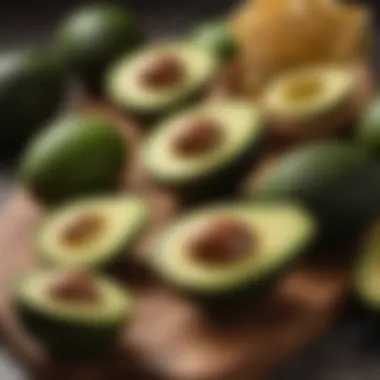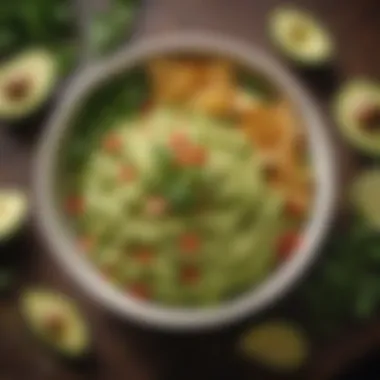Crafting Guacamole with One Avocado: A Practical Guide


Recipe Highlight
Creating a simple yet delicious guacamole is entirely possible with just one avocado. This guide simplifies the process for those with busy lifestyles, without compromising flavor.
Essential Ingredients
- 1 ripe avocado
- 1 small tomato
- 1/4 small onion
- 1 lime (for juice)
- Salt (to taste)
- Fresh cilantro (optional)
Estimated Time
- Preparation Time: 10 minutes
- Total Time: 10 minutes
Servings
This recipe yields approximately 2 servings, making it perfect for a small snack or as an appetizer.
Step-by-Step Instructions
- Prepare the avocado: Cut the avocado in half, remove the pit, and scoop the flesh into a mixing bowl.
- Mash the avocado: Use a fork or a potato masher to mash the avocado to your desired consistency—smooth or chunky.
- Chop the tomato and onion: Dice the tomato and onion finely. Add them to the mashed avocado.
- Add lime juice: Squeeze the juice of one lime over the mixture to enhance flavor and prevent browning.
- Season: Add salt incrementally, mixing well to taste. If you like, chop fresh cilantro and fold it into the guacamole.
Cooking Techniques
- Mashing: The method used for mashing can greatly influence the texture. A fork offers more control for a chunkier texture.
Insider Advice
- Use a ripe avocado. If it's hard, leave it at room temperature for a few days until it gives slightly when pressed.
- Avoid over-mixing; it may turn your guacamole into a paste.
Common mistakes include using unripe avocados or forgetting to add lime, which is crucial for flavor.
Variations and Substitutions
- Alternative Ingredients: Replace diced tomato with roasted red pepper for a different flavor.
- Extra Flavors: Incorporate a pinch of cumin or chili powder for a spicy kick.
- Pairing Ideas: Serve with tortilla chips, vegetable sticks, or as a topping for tacos or salads.
Time-Saving Cooking Tips
- Prep Ingredients: Chop the onion and tomato ahead of time and store them in the fridge to save prep time.
- Tools: A small mixing bowl and fork are all that’s needed; however, a hand masher can speed up the mashing process.
Multiple Meals
Make it a part of a meal prep routine; guacamole can be easily stored in an airtight container for up to two days in the fridge.
Nutritional Information
- Caloric Content: Approximately 120 calories per serving.
- Key Nutrients: Provides healthy fats, fiber, and vitamins such as Vitamin C and E.
This recipe is suitable for various diets, including vegan and gluten-free plans.
Guacamole not only enhances the taste but also packs nutritional value, making it a smart addition to your diet.
By following this guide, making guacamole with just one avocado becomes a practical and enjoyable task. The easy steps and variations allow for personalization, catering to your palate without complicating the process.
Prolusion to Guacamole
Guacamole holds a significant place in culinary history, acting as both a traditional dish and a versatile condiment. This introduction provides insight into the depth of guacamole’s cultural relevance and its enduring popularity. Understanding the layers of this simple avocado dish can enhance the preparation experience.


Guacamole’s importance is not just about flavor. It represents a connection to culinary traditions and health-conscious eating. By crafting guacamole with a single avocado, individuals can enjoy an authentic taste without excess waste. The objective of this guide is to demystify the preparation process, making it accessible to even the busiest of individuals.
The Origin of Guacamole
Guacamole originated in Central Mexico, dating back to the Aztecs who created it using avocados, tomatoes, and spices. This ancient dish was not merely food; it symbolized a fusion of culture and agriculture. Over centuries, it evolved, integrating regional flavors and ingredients. Today, guacamole is not only celebrated in Mexican cuisine but has also gained global acclaim, often being featured in various culinary styles.
The early use of the avocado is significant. Aztecs regarded the fruit highly - rich in nutrients and flavor.
"Avocados were considered a source of fertility by the ancient civilizations of Mesoamerica," showcasing their cultural importance.
Guacamole's versatility allows it to adapt to various taste preferences. Whether mild or spicy, traditional or innovative, each preparation tells a story.
Health Benefits of Avocado
Avocado, the star ingredient of guacamole, is renowned for its health benefits. This nutrient-rich fruit is loaded with vitamins, minerals, and heart-healthy fats. Including avocado in your diet can improve cardiovascular health, assist in weight management, and promote overall well-being.
Some key benefits of avocados include:
- High in Nutrients: Avocados are a great source of vitamins E, K, and C, as well as potassium.
- Rich in Healthy Fats: These monounsaturated fats contribute to better heart health and can help reduce bad cholesterol levels.
- Fiber Content: Avocados are high in fiber, promoting digestive health and providing a feeling of fullness.
Incorporating guacamole into meals allows for a flavor-packed option that also supports health goals. Thus, making a guacamole with one avocado not only satisfies taste but also aligns with a health-conscious lifestyle.
Required Ingredients for Guacamole
The choice of ingredients is fundamental in creating guacamole that will satisfy both the palate and the nutritional needs. In this section, we delve into the essential items required to craft a basic yet delectable guacamole. We also explore optional additions that can enhance the flavor or introduce a new twist to the traditional recipe. Choosing the right ingredients ensures that the guacamole will not only taste good but also offer health benefits and compatibility with various serving options.
Essential Items
For a basic guacamole using one avocado, certain items are indispensable. These ingredients create the backbone of the flavor and texture. The following are must-have items for your guacamole:
- Ripe Avocado: The star of the dish. A ripe avocado offers a creamy texture and buttery flavor. When selecting, inspect for firmness. A slight give when pressed indicates ripeness.
- Salt: This simple seasoning is crucial. It enhances flavor and balances the richness of the avocado. Using sea salt or kosher salt can offer better flavor dimensions.
- Lime Juice: Provides acidity. It brightens the overall taste and helps prevent the avocado from browning too quickly. Freshly squeezed lime juice is preferable for optimal flavor.
- Onion: Diced onion adds crunch and sharpness. Red onion is often chosen for its color and milder flavor compared to white onions.
- Tomato: Adds freshness. When used, opt for ripe tomatoes, as they contribute additional moisture and sweetness to the guacamole.
Together, these ingredients create a classic guacamole that showcases the avocado's natural flavor while seasoned perfectly to please your palate.
Optional Additions
While the essential items provide a great base, enhancing guacamole can be done with various optional ingredients. These can introduce diverse flavors and textures, making your concoction unique:
- Cilantro: Fresh cilantro offers a herbaceous note that pairs well with the other ingredients. Chopped finely, it can elevate the freshness of the guacamole.
- Chili: Adding some form of heat can customize your guacamole. Hot sauce or chopped jalapeños add spiciness and flavor complexity.
- Garlic: Fresh minced garlic can provide depth. It infuses a robust flavor. However, use it sparingly to avoid overpowering the dish.
- Peppers: Sliced or chopped bell peppers can provide a crunchy texture, adding color and sweetness.
- Corn: For a sweet crunch, adding corn can transform the dish, giving it a distinct American twist.
Incorporating these optional items can cater to personal tastes and dietary preferences. Experimenting with them can lead to discovering your favorite guacamole variation.
Remember: Simplicity is key, but creativity can enhance your culinary experience. Each additional ingredient should complement the avocado rather than mask its flavor.
Necessary Tools for Preparation
Creating guacamole requires not just skill but also the appropriate tools to make the process efficient and enjoyable. Having the right tools on hand ensures that chopping, mixing, and serving go smoothly. This section will cover essential cutting tools, mixing utensils, and serving containers that will enhance your guacamole-making experience.
Cutting Tools
When crafting guacamole from a single avocado, effective cutting tools are essential for easy and precise preparation. A sharp chef’s knife is necessary for halving the avocado and removing the pit. The sharpness ensures clean cuts, reducing the risk of bruising the avocado flesh which might affect the final texture of the guacamole.
A simple paring knife can come in handy for smaller tasks like slicing other ingredients, such as onions or tomatoes, that you might want to include in your guacamole. Ensure that your cutting board is firm and stable. A bamboo or plastic cutting board can provide a good surface from which to work.
The right cutting tools can significantly improve your efficiency and the final taste of your guacamole.


Mixing Utensils
Mixing utensils play a crucial role in achieving the desired consistency of your guacamole. A sturdy fork or a potato masher allows for easy mashing of the avocado. If you prefer a chunkier texture, simply mash gently. For a smoother mixture, continue mashing until you reach your desired level.
Another important tool is a mixing bowl. A medium-sized bowl gives you enough space to blend ingredients without creating a mess. If you intend to incorporate more solid ingredients, selecting a bowl with tall sides can help keep everything contained. For those who want to experiment with flavor, a whisk can also be used to blend in spices and seasonings more effectively.
Serving Containers
Serving containers are essential for presenting your guacamole attractively. A simple, small bowl is traditional, allowing for easy scooping and enjoying. If you fancy a touch of elegance, opt for a ceramic bowl or a wooden dish. These materials often retain the avocado's freshness longer than plastic and add an appealing aesthetic.
For parties or gatherings, consider using individual portions if you are serving several people. Small cups or mini ramekins can be great for offering personal servings, making for an engaging dining experience. Remember, the container should complement the flavors of the guacamole while also serving a practical purpose in terms of size and ease of use.
Step-by-Step Preparation Process
The preparation process is vital when crafting guacamole. This section breaks down the steps to ensure each stage is clear and effective. Understanding these steps helps in creating a flavorful guacamole efficiently. Following precise methods can also enhance the overall experience. The focus on a methodical approach allows for greater control over flavor and texture.
Selecting the Right Avocado
Choosing the right avocado is fundamental. You need to find an avocado that is ripe but not overripe. A ripe avocado yields slightly to gentle pressure. If it feels hard, it may not be ready. If it is too soft, it may be spoiled. Look for an avocado with a dark green or nearly black skin. The stem end should be green and not brown. Examining the avocado's skin can provide crucial insights. This careful selection sets the base for a successful guacamole.
Preparing the Avocado
Once you have selected the right avocado, the next step is preparation. Start by washing the avocado under running water to remove any dirt. Then, cut the avocado in half longitudinally. Using a sharp knife, carefully twist to separate the two halves. You will encounter the pit in one half. To remove it safely, tap the pit with the knife blade and twist to dislodge it. Use a spoon to scoop out the flesh into a bowl. Make sure to avoid any skin, as it can alter the taste.
Mixing Ingredients
Mixing the ingredients is where personalization begins. Traditional guacamole includes lime juice, salt, and often tomatoes, onion, and cilantro. However, you may choose to add other elements such as garlic or jalapeños. Start by mashing the avocado in the bowl using a fork or a potato masher. Gradually fold in the other ingredients. Adjust quantities according to your taste preferences. It is important that this step is done gently, ensuring some chunks of avocado remain for texture.
Achieving Desired Consistency
Consistency is crucial in guacamole preparation. It is a balance between smoothness and chunkiness. If you prefer a creamier guacamole, mash it more thoroughly. Conversely, for a chunkier texture, leave larger pieces of avocado intact. After mixing, taste the guacamole, adjusting seasoning or additional ingredients if needed. Letting it rest for a few minutes can also allow the flavors to meld together before serving. This final touch ensures satisfaction with each bite.
Taste and Adjustments
The taste and adjustments in guacamole preparation are significant because they determine the overall flavor profile of the final product. Making guacamole can be a straightforward process, but small changes can lead to vastly different outcomes. Understanding how to test flavor profiles and implement common adjustments can elevate a simple dish into a culinary delight that caters to personal preferences and enhances dining experiences. The objective is to create a balanced blend of flavors that complements the creamy texture of the avocado while ensuring it meets the taste standards of those who will enjoy it.
Testing Flavor Profiles
When crafting guacamole, it is crucial to taste components individually and as a whole. Begin by mixing the essential ingredients—mashed avocado, salt, and any acids like lime juice. After combining, take a small sample. This initial tasting will highlight the primary flavor notes and reveal whether the balance is appropriate.
- Salt enhances flavor; too little may render it bland.
- Lime juice adds freshness and acidity, but too much can overpower the avocado.
- Onion and garlic bring depth but need careful handling so they do not dominate.
Adjustments should be made gradually. After each addition, taste again. This stepwise process ensures that each ingredient contributes positively without overshadowing others. Flavor profiles can be adjusted for personal preferences, making it more enjoyable for oneself or guests.
Common Adjustments
Once the tasting is complete, consider these common adjustments to refine the guacamole:
- Increase Acid: If the guacamole lacks brightness, add more lime or lemon juice.
- Enhance Saltiness: If it tastes flat, gradually incorporate more salt until the flavors pop.
- Add Sweetness: A pinch of sugar or honey can balance en overpowering acidity.
- Introduce Heat: For spiciness, add chopped jalapeños or red pepper flakes, adjusting to personal preference.
- Herbs and Spices: Fresh cilantro or cumin can add unique layers of flavor.
- Texture Considerations: If too chunky, mash more; if too smooth, fold in diced avocado for variance.
By being aware of these adjustments, the guacamole can be tailored to fit various palates. The important thing is to remain open-minded during this process, as a successful guacamole is often a product of experimentation.
"Cooking is all about balancing flavors. A little adjustment can turn a good dish into a great one."
Serving Suggestions


Serving suggestions are crucial for getting the most out of your guacamole. While the preparation process can be enjoyable, presenting your creation in an appealing manner can enhance the experience for your guests or your own enjoyment. Thoughtful serving not only elevates the dish but can also invite creativity in how the guacamole is utilized. The right pairing can transform an average snack into a delightful culinary experience.
Ideal Pairings
When it comes to guacamole, the versatility in pairings is extensive. Here are some ideal options that complement the flavors of freshly made guacamole:
- Tortilla Chips: This is the classic accompaniment. The crunchiness of the chips contrasts nicely with the creaminess of the guacamole, providing a satisfying texture.
- Vegetable Sticks: Carrot, celery, and cucumber sticks are healthy alternatives. They provide a fresh taste and additional crunch.
- Tacos: Using guacamole as a topping for tacos can enhance the flavor profile. The richness of the avocado pairs well with spicy meats or beans.
- Sandwiches and Wraps: Spread guacamole on sandwiches or wraps for added creaminess and flavor. It can be a healthier alternative to mayonnaise or dressings.
- Egg Dishes: Whether in scrambled eggs or as part of a breakfast burrito, guacamole adds depth and richness to egg-based recipes.
The options are numerous, but the goal should always be to balance the flavors so that the guacamole stands out.
Presentation Options
Presentation plays a significant role in how food is perceived. For guacamole, consider these ideas:
- Serving Bowl: Use a contrasting bowl color to make the green of the guacamole pop. Natural materials can add a rustic touch.
- Garnishes: A sprinkle of chopped cilantro, diced tomatoes, or a few slices of jalapeño on top can provide visual interest. You can also try drizzling a bit of lime juice for a shine and colorful effect.
- Dipping Bar: Arrange various dippers around the guacamole. Include tortilla chips, vegetable sticks, and even crackers on a large platter. This not only makes it delightful visually but also encourages sharing.
- Individual Portions: Serve in small cups or stoneware for individual servings. It presents a clean and tidy way to offer the guacamole and limits mess.
To sum it up, pairing and presentation significantly enhance the overall guacamole experience. Attention to these elements adds value and demonstrates thoughtfulness to those being served. "Remember that a well-presented dish is half the meal." When planning serving suggestions, let your creativity and personal taste guide you.
Storage and Shelf Life
Understanding how to properly store guacamole is essential for maintaining its flavor and texture. Unlike some condiments or dips, guacamole is best consumed fresh. However, with the right techniques, you can preserve its quality and enjoy it even days after preparation. This section addresses key points related to the storage and shelf life of guacamole made from one avocado. By knowing how to store it and identifying signs of spoilage, you can minimize waste and enjoy your creation for longer.
Proper Storage Techniques
To store guacamole effectively, consider these techniques:
- Use an Airtight Container: After preparing your guacamole, transfer it into a small, airtight container. This limits exposure to air, which can accelerate browning due to oxidation.
- Press Plastic Wrap Against the Surface: If you do not have a suitable container, use plastic wrap. Press the wrap firmly against the top of the guacamole. Ensuring there are no air pockets can help reduce oxidation.
- Add a Layer of Lime Juice: Sprinkling a thin layer of lime or lemon juice over the surface of the guacamole can act as a natural preservative. The acidity slows down the browning process.
- Keep in the Fridge: Always store guacamole in the refrigerator. The cool temperature slows down bacterial growth and helps retain freshness.
By following these steps, you can extend the shelf life of your guacamole for up to two days, although it's ideal to consume it within the first day for the best taste.
Signs of Spoilage
Even with proper storage, guacamole can spoil. Be vigilant about the following signs:
- Change in Color: A change from vibrant green to brown indicates oxidation. While some brown guacamole is still safe to eat, it may not be very appetizing. You can scrape off the brown layer to find greener guacamole underneath.
- Unpleasant Odor: Fresh guacamole should have a creamy avocado smell. If it starts to smell sour or off, discard it.
- Texture Changes: If you notice excessive watery separation, it may indicate spoilage. While sometimes liquid can separate, an unusual texture can warrant disposal.
- Mold Growth: Any signs of mold clearly indicate that the guacamole has gone bad. Mold can appear fuzzy or discolored and should not be consumed under any circumstances.
Proper care and attention to storage can greatly prolong the enjoyment of your guacamole.
Epilogue
In this article, we examined how to craft guacamole with one avocado. The conclusion draws together various aspects essential for creating this popular dish while ensuring that it suits individuals with busy lifestyles. Guacamole is not merely a side dish; it represents a blend of flavors and health benefits, making it a valuable addition to any meal.
The simplicity of using just one avocado highlights convenience while maintaining quality. Preparing guacamole can be executed swiftly and efficiently, allowing anyone to enjoy a fresh, healthy dip with minimal fuss.
Key components to consider are:
- Ingredients: Focusing on basic and optional ingredients enhances the culinary experience without overwhelming the cook.
- Tools: Simple utensils suffice for the preparation, which encourages everyone to try their hand at making this dish.
- Storage: Proper storage techniques extend the shelf life of guacamole, minimizing waste and ensuring freshness.
Ultimately, guacamole not only serves as a flavorful contribution to meals but also promotes health.
The versatility and ease of preparing guacamole make it an exemplary dish for both novice and experienced cooks.
As we reflect on the preparation process, the concluding thoughts remind readers that mastering this dish adds a valuable skill to their culinary repertoire. Embrace the process, adjust flavors to personal preferences, and enjoy the satisfaction of creating a gourmet experience from the comfort of home.
Final Thoughts on Guacamole Preparation
The final thoughts focus on the joy and art of preparing guacamole. Developing an understanding of how to craft this dish empowers cooks to explore variations and improvements.
Engaging with the preparation process opens doors to creativity. One may experiment with different textures and flavor profiles, reflecting personal preferences and dietary needs.
- Avocado ripeness affects taste, so selecting the right fruit is crucial.
- Common additions such as garlic or lime can be modified based on individual palates.
Consider guacamole as a foundation. From here, the possibilities expand into various ways to enjoy it—be it on tacos, as a dip, or as an accompaniment to grilled meats.







